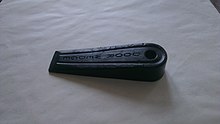Doorstop



A doorstop (also door stopper, door stop or door wedge) is an object or device used to hold a door open or closed, or to prevent a door from opening too widely. The same word is used to refer to a thin slat built inside a door frame to prevent a door from swinging through when closed. A doorstop (applied) may also be a small bracket or 90-degree piece of metal applied to the frame of a door to stop the door from swinging (bi-directional) and converting that door to a single direction (in-swing push or out-swing pull). The doorstop can be a separate part or integrated with a hinge or door closer.
History
[edit]Formally-produced doorstops trace their history to the 18th century in Europe, becoming widely manufactured in Europe in the early 19th century. By the mid 19th century, manufacturing had primarily moved to the United States.[1] Despite their early manufacturing, credit for the invention of the doorstop is usually granted to Osburn Dorsey, an American inventor, in 1878. The doorstop was Dorsey's most famous invention and he received a US patent, number 210,764, for the invention.[2]
Usage
[edit]Holding doors open
[edit]A door may be stopped by a doorstop which is simply a heavy solid object, such as a brick, placed in the path of the door. These stops are predominantly improvised.[1] Historically, lead bricks have been popular choices when available.[3] However, as the toxic nature of lead has been revealed, this use has been strongly discouraged.[4]
Another method is to use a doorstop which is a small wedge of wood, rubber, fabric, plastic, cotton or another material. Manufactured wedges of these materials are commonly available. The wedge is kicked into position and the downward force of the door, now jammed upwards onto the doorstop, provides enough static friction to keep it motionless.[5]
A third strategy is to equip the door itself with a stopping mechanism. In this case, a short metal bar capped with rubber, or another high-friction material, is attached to a hinge near the bottom of the door opposite the door hinge and on the side of the door which is in the direction that it closes. When the door is to be kept open, the bar is swung down so that the rubber end touches the floor. In this configuration, further movement of the door towards being closed increases the force on the rubber end, thereby increasing the frictional force which opposes the movement. When the door is to be closed, the stop is released by pushing the door slightly more open, which releases the stop and allows it to be flipped upwards. A newer version of equipping the door with the stopping mechanism is to attach a magnet to the bottom or top of the door on the side which opens outward, which then latches onto another magnet or magnetic material on the wall or a small hub on the floor. The magnet must be strong enough to hold the weight of the door, but weak enough to be easily detached from the wall or hub.[6]
-
A metal brick used as a doorstop
-
A commercially available rubber doorstop
-
A door mounted doorstop
-
A decorative concrete doorstop
Preventing damage by doors
[edit]Another type of doorstop is used to prevent doors from opening too far and damaging nearby walls. In this case a rubber cylinder or dome—or a rod or block of rubber-tipped metal, wood or plastic—is screwed into the wall, molding or the floor in the path of the door. If it is attached to the wall, it may be either a few inches above the ground, or at such a height as to meet the doorknob. A short, wall-attached doorstop, usually a rubber dome or cylinder, is sometimes called a wall bumper. Rigid metal springs (also tipped with rubber or plastic) are used to absorb and more widely distribute the kinetic energy of the door swinging.
On occasion, stops are used that are fitted at the midpoint of the door, as part of the central door-hinge. Such stops are known as a "hinge stops" or "hinge pin" doorstops and are often used to prevent damage to baseboard molding.[7]
-
A doorknob-blocking wall mounted doorstop, also called a "wall bumper"
-
A floor mounted doorstop
-
The consequences of lacking a doorstop
-
Rigid metal spring doorstop in solid baseboard molding
Holding doors closed
[edit]In his 1906 book The Right Way to Do Wrong, Harry Houdini recommends the use of a doorstop wedge to prevent a door from being pushed open from the outside, to deter burglars at night.[8]
Dialect usage
[edit]In various British English dialects, including those in the south-west, north-east and north-west of England, the word "doorstop" is cognate with "doorstep" in standard English, being derived from door and stoop.[citation needed]
References
[edit]- ^ a b Smith, John C. and Nancy M. (23 August 2006). "Collecting Doorstops". The Journal of Antiques and Collectibles. Retrieved 27 October 2020.
- ^ Katz, Jeff. "Who Invented the Door Stop?". Home Guides | SF Gate. Retrieved 27 October 2020.
- ^ Prose, Elizabeth. "Those Weird Victorians: Knit Weldon's Lead Cushion, or Door Stop". PieceWork. Retrieved 27 October 2020.
- ^ Phelps, Anne. "Lead-Safe Housing Policy Guidance" (PDF). Centers for Disease Control.
- ^ Thompson, Sara (1 October 2020). "Explorit: Everyday simple machines". Davis Enterprise. Retrieved 27 October 2020.
- ^ Mead, Taylor (1 March 2019). "This Is the World's Most Attractive Doorstop—Yes, It's Invisible". House Beautiful. Retrieved 27 October 2020.
- ^ Klimek, Mike (10 September 2016). "Two types of doorstops have advantages, disadvantages". Las Vegas Review-Journal. Retrieved 27 October 2020.
- ^ Houdini, Harry (March 2007). The Right Way to Do Wrong: An Exposé of Successful Criminals. Cosimo, Inc. ISBN 978-1-60206-078-4.
External links
[edit] Media related to Doorstops at Wikimedia Commons
Media related to Doorstops at Wikimedia Commons








